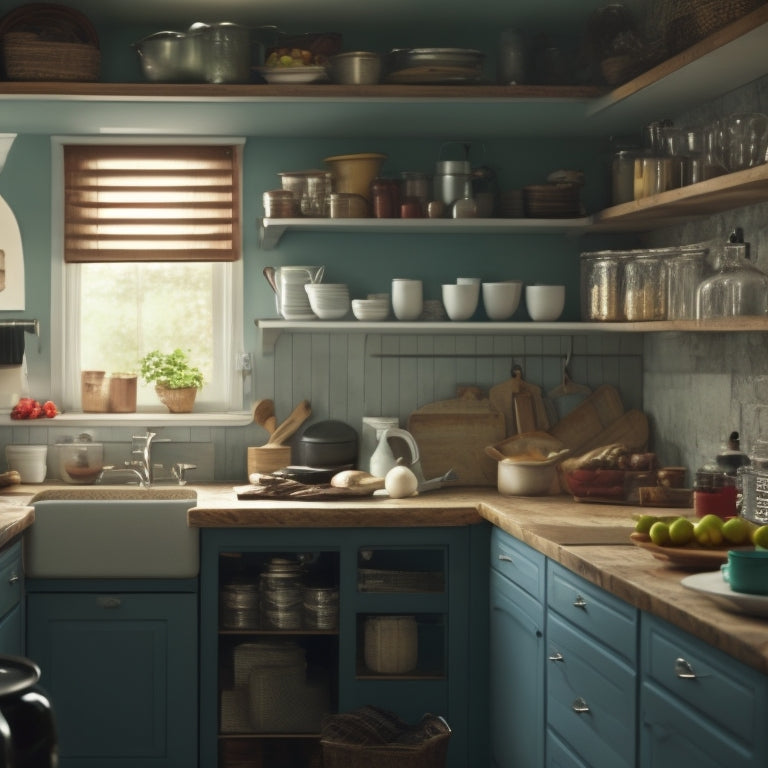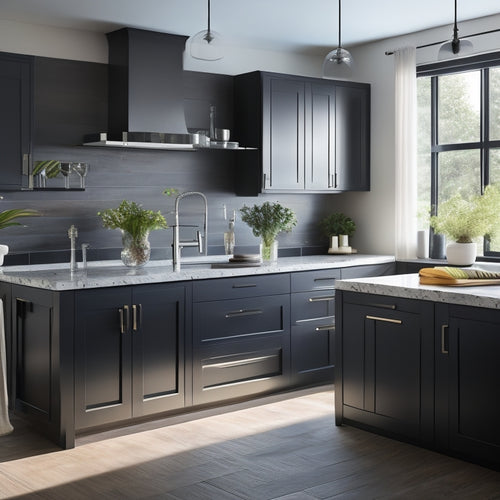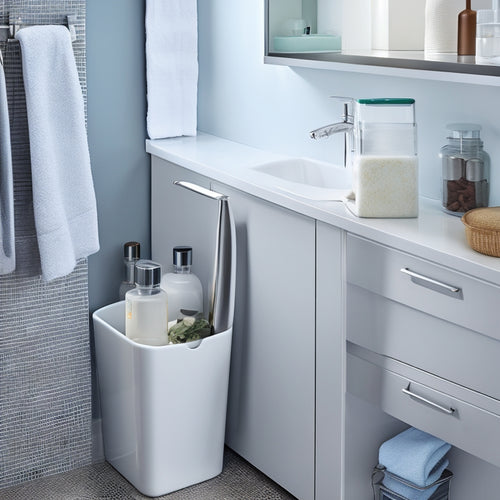
What's Holding You Back From Open Kitchen Shelving?
Share
You're hesitant to adopt open kitchen shelving because clutter, space, and budget concerns are holding you back. You envision a serene, sophisticated kitchen, but worry that shelves will create a chaotic look. You're unsure about optimizing your kitchen's spatial constraints or finding affordable shelving options. Perhaps you're concerned about the perceived lack of storage or the challenge of installation. Whatever the reason, rest assured that with strategic planning, clever design, and intentional curation, your open kitchen shelving can become a stunning focal point. Now, take the first step towards transforming your kitchen, and discover the secrets to making it a reality.
Key Takeaways
• Fear of cluttered kitchen appearance and chaotic look without cabinets holds many back from open kitchen shelving.
• Limited kitchen space and concerns about exacerbating spatial constraints are common obstacles to open shelving.
• Budget constraints and perceived lack of affordable storage options often prevent people from adopting open shelving.
• Difficulty with shelving installation, including measuring mistakes and ensuring level and secure shelves, is a significant deterrent.
• Concerns about cleaning and maintenance, including dust accumulation and hidden dust traps, also discourage people from open kitchen shelving.
Fear of Cluttered Kitchen Appearance
As you envision your dream kitchen, the fear of a cluttered kitchen appearance likely holds you back from embracing open kitchen shelving, where every item is on full display. You worry that without cabinets, your kitchen will look chaotic and disorganized.
But, what if you could create a space that exudes serene sophistication, even with open shelving? The key lies in thoughtful curation. By intentionally selecting a few, beautiful pieces to display, you can create a visually stunning kitchen that sparks joy, not stress.
Visual clutter, after all, can contribute to mental stress, making it difficult to relax in your own space. By editing your possessions and choosing only what brings you joy, you can create a sense of calm and tranquility in your kitchen.
Imagine sipping coffee in a bright, airy space, surrounded by only your favorite pieces. It's achievable, and open kitchen shelving can help you get there.
Limited Kitchen Space Concerns
You're likely worried that open kitchen shelving will only exacerbate your limited kitchen space concerns, making the area feel cramped and claustrophobic. However, with strategic planning, open shelving can actually help optimize your kitchen's spatial constraints.
By installing shelves that wrap around corners, you can create additional storage without sacrificing floor space. This corner optimization technique allows you to make the most of often-wasted areas, keeping your kitchen organized and clutter-free.
Compact designs are another key consideration for small kitchens. Look for slim, wall-mounted shelves that don't protrude too far into the room, keeping the floor clear and creating a sense of openness. You can also choose shelves with built-in dividers or baskets to keep items neatly categorized and out of sight.
Budget Constraints Holding You Back
Budget constraints often cast a shadow over your kitchen renovation dreams, making it seem impossible to incorporate open shelving into your design without breaking the bank. However, with some careful financial planning, you can achieve the look you want without sacrificing your savings.
One cost-effective alternative is to repurpose existing materials, such as reclaimed wood or vintage shelving units, to create a unique and budget-friendly open shelving system. You can also consider DIY projects, like building your own shelves or upcycling old furniture, to save on labor costs.
Additionally, shopping during sales or using coupons can help you score discounts on the materials you need. By prioritizing your spending and getting creative with your design, you can create a beautiful open shelving system that fits your budget and style.
With a little resourcefulness, you can turn your kitchen renovation dreams into a reality without breaking the bank.
Perceived Lack of Storage Options
While you're freeing up visual space with open kitchen shelving, you're likely wondering where to stash the items you don't want on display, which can lead to concerns about adequate storage. This perceived lack of storage options might be holding you back from embracing the open shelving trend. However, with some strategic planning, you can maximize your storage capacity and create a functional, visually appealing space.
Here are some ways to optimize your storage:
-
Double-duty shelves: Choose shelves with built-in storage, such as cabinets or drawers, to keep items hidden from view.
-
Tiered shelf configuration: Design your shelves with varying heights to create separate areas for different items, keeping similar items together.
-
Basket and bin storage: Use decorative baskets and bins to store items like spices, oils, or cooking utensils, keeping them organized and out of sight.
- Wall-mounted storage: Install wall-mounted shelves, hooks, or a pegboard to hang items like pots, pans, and utensils, freeing up shelf space for decorative items.
Difficulty With Shelving Installation
One common hurdle to overcome when embracing open kitchen shelving is managing the installation process, which can be challenging, especially for DIY enthusiasts or those without prior experience. You might worry about measuring mistakes, which can lead to ill-fitting shelves or uneven spacing. This anxiety can be overwhelming, causing you to question your ability to tackle the project.
DIY anxiety is a real concern, especially when it comes to open kitchen shelving. You'll need to make sure that your shelves are level, secure, and visually appealing.
To overcome this hurdle, take your time, and double-check your measurements. Consider enlisting the help of a friend or professional if you're not confident in your abilities. Remember, it's better to take it slow and get it right than to rush through the installation process and risk costly mistakes.
Aesthetics and Style Uncertainty
You'll likely spend hours pouring over design blogs and Pinterest boards, yet still struggle to pinpoint a style that resonates with your personal taste and complements your kitchen's unique architecture. This is a common design dilemma, especially when it comes to open kitchen shelving.
The fear of committing to a specific aesthetic can be overwhelming, causing you to second-guess your design choices.
To overcome this uncertainty, consider the following:
-
Define your style: Identify the elements that speak to you, whether it's modern minimalism or rustic charm. This will help you narrow down your design options.
-
Visualize the flow: Think about how you want the eye to move through your kitchen. Open shelving can create a sense of visual flow, so consider how you can use it to guide the viewer's attention.
-
Balance contrast: Combine different materials, textures, and colors to create visual interest. This will help distract from any potential imperfections and create a cohesive look.
- Seek inspiration: Look to designs that resonate with you, and try to recreate the essence of what you love about them in your own kitchen.
Concerns About Dust Accumulation
As you consider open kitchen shelving, you're probably wondering how to mitigate the inevitable dust accumulation.
You'll need to think about the potential consequences of dust buildup, such as attracting unwanted pests and requiring frequent shelf cleaning.
From hidden crevices to exposed surfaces, every nook and cranny will demand your attention to maintain a clean and hygienic kitchen environment.
Dust Attracts Pests
With open kitchen shelving, dust accumulation can become a serious concern, especially since it attracts pests that can contaminate your food and cooking surfaces. As a homeowner, you're probably aware of the importance of pest control, but you mightn't realize how dust mites and other pests can thrive in a dusty kitchen environment.
Here are some reasons why dust accumulation on open kitchen shelving can attract pests:
-
Dust mites: These microscopic creatures feed on human skin cells and thrive in dusty environments. They can trigger allergies and asthma attacks.
-
Cockroaches: These pests are attracted to food crumbs and spills, which can accumulate on open kitchen shelves.
-
Rodents: Mice and rats can be drawn to dusty shelves, especially if they're storing food or pet food.
- Flies: Houseflies and fruit flies can lay eggs in dusty areas, leading to more pest problems.
Shelves Need Frequent Cleaning
Regular cleaning is essential to prevent dust accumulation on open kitchen shelves, which can become a breeding ground for pests if left unchecked. You don't want to create an environment that's conducive to unwanted critters, do you? To maintain a dust-free zone, establish a dusting schedule that works for you. This can be as simple as dedicating 10 minutes a day or 30 minutes a week to wiping down your shelves.
| Cleaning Rituals | Frequency |
|---|---|
| Quick dusting with a microfiber cloth | Daily |
| In-depth dusting with a damp cloth | Weekly |
| Deep cleaning with a gentle cleanser | Bi-Weekly |
| Inspecting for dust accumulation | Monthly |
| Reorganizing and decluttering | Quarterly |
Hidden Dust Traps
Behind the visually appealing display of cookbooks, decorative vases, and kitchen gadgets, dust accumulation can secretly thrive in hidden areas, such as the narrow crevices between shelf boards, the undersides of decorative items, and the tight spaces behind wall-mounted shelves. You mightn't notice it at first, but dust bunnies can multiply quickly, making your open shelving look cluttered and neglected.
Here are some common hidden dust traps to watch out for:
-
Shadowy corners: Where shelves meet walls, creating a triangle of darkness that's perfect for dust accumulation.
-
Undersides of decorative items: Vases, baskets, and other decorative pieces can collect dust on their undersides, which can be hard to reach.
-
Narrow crevices between shelf boards: These small gaps can be a haven for dust and dirt.
- Tight spaces behind wall-mounted shelves: These areas can be difficult to clean, making them a breeding ground for dust.
Prioritizing Cabinets Over Shelves
Designing an open kitchen, you're likely torn between allocating valuable wall real estate to cabinets or shelves, but prioritizing cabinets can be a smart move. Cabinets have long been the go-to choice for kitchen storage, and for good reason. They provide a clean, streamlined look that's deeply ingrained in our collective design consciousness - a reflection of the enduring power of Cabinet Culture.
By opting for cabinets, you're tapping into this Design Default, creating a sense of familiarity and comfort in your kitchen. Cabinets also offer a level of concealment that shelves can't match. They keep clutter at bay, hiding away less-than-photogenic kitchen essentials like trash cans and cleaning supplies.
This allows you to focus on showcasing your favorite dishes, cookbooks, or decorative pieces on shelves or countertops, creating a visually appealing contrast. By prioritizing cabinets, you're not only honoring the design norms of the past but also setting yourself up for a more polished, put-together kitchen that exudes a sense of belonging.
Alternative Storage Solutions Preferred
What if you're not beholden to Cabinet Culture, and instead, you're drawn to the aesthetic of open kitchen shelving, where every item is on display, and the beauty lies in the intentional curation of your kitchen essentials? You might be someone who values flexibility and adaptability in your kitchen design. Perhaps you're looking for alternative storage solutions that reflect your personal style.
Here are some options to explore:
-
Hidden compartments: Incorporate hidden compartments or drawers within your shelving units to store items you don't want on display, like special occasion dishes or kitchen gadgets.
-
Decorative baskets: Use decorative baskets or containers to store items like spices, oils, or snacks, adding a touch of warmth and texture to your kitchen.
-
Pegboards: Install a pegboard on a wall or the back of a door, and hang your most-used items, like pots, pans, or utensils, keeping them within easy reach.
- Magnetic strips: Add magnetic strips to your shelving or walls, and store metal items like knives, spices, or oils, keeping your countertops clear.
Uncertainty About Shelf Placement
As you envision your open kitchen shelving, you're likely wondering where to place those shelves to maximize functionality and visual appeal. This importance of shelf placement can be a significant hurdle in embracing open kitchen shelving.
One key aspect to keep in mind is shelf height. Placing shelves at varying heights can create a visually appealing layered look, while also ensuring that frequently used items are within easy reach. For instance, reserve lower shelves for heavy cookbooks or infrequently used items, and reserve upper shelves for decorative pieces or special occasion dishes.
Corner optimization is another essential consideration. Corners can be notoriously tricky to navigate, but clever shelf placement can turn these areas into functional hubs. Consider installing corner shelves or carousels to maximize storage and make the most of these often-wasted spaces.
Frequently Asked Questions
Can I Mix Open Shelving With Traditional Cabinets?
You can absolutely mix open shelving with traditional cabinets, creating a visually appealing contrast that enhances your kitchen's design flow. By balancing open and closed storage, you'll establish a harmonious visual hierarchy that makes your space feel cohesive and inviting.
How Do I Choose the Right Type of Shelf Material?
"As you step into your dream kitchen, imagine a canvas of shelves showcasing your treasures. To bring this vision to life, you'll want to choose shelf materials that marry aesthetics with durability, ensuring your open shelving masterpiece stands the test of time."
Will Open Shelving Make My Kitchen Look Messy?
You're wondering if open shelving will make your kitchen look messy? It depends on your personal style and clutter threshold. If you're a tidy soul, open shelves can showcase your curated kitchenware, but if you're a clutterbug, it may accentuate the chaos.
Can I Add Open Shelving to an Existing Kitchen Layout?
You can definitely add open shelving to your existing kitchen layout, but you'll need to take into account structural limitations and renovation logistics, ensuring your design vision aligns with the space's constraints to create a cohesive, stylish look.
Are There Any Specific Design Rules for Open Shelving?
'You're on the right track! When designing open shelving, think of it as a 'piece of art' - aim for visual balance by mixing large and small items, and make sure shelf proportion is harmonious, creating a sense of cohesion.'
Related Posts
-

Revolutionize Your Kitchen With Sink Upgrades
Revamp your kitchen by enhancing your sink with thoughtfully chosen accessories, transforming it into a multitasking ...
-

Revamp Your Under-Sink Setup Like a Pro
To revamp your under-sink setup like a pro, start by evaluating your space and categorizing existing items, taking no...

